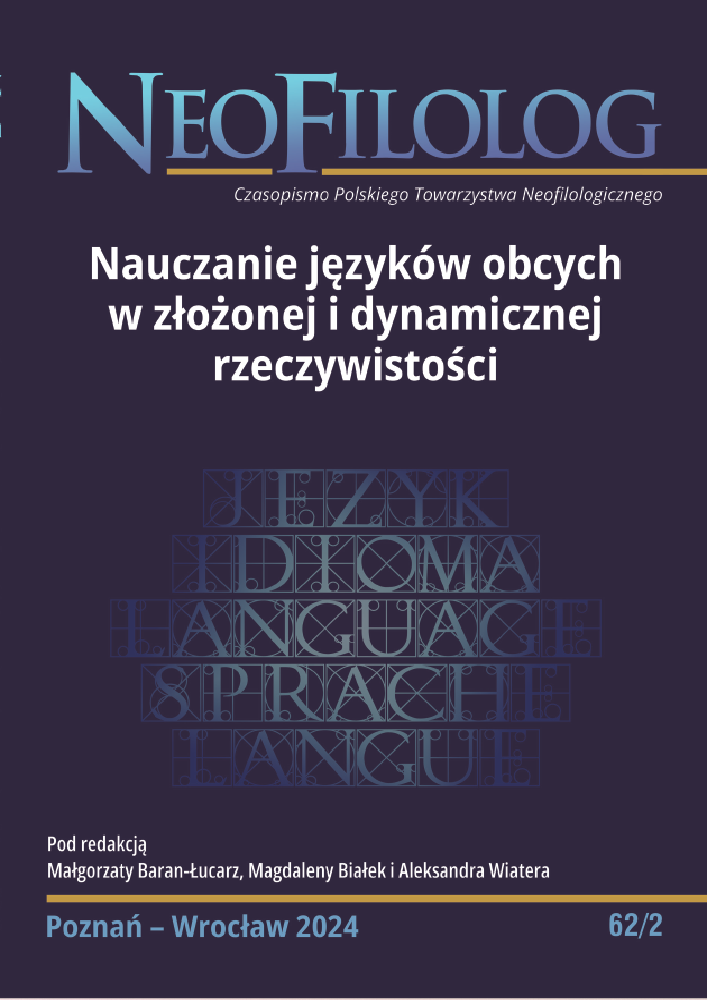Abstrakt
Reading is an important element of independent work on the language, but offering students additional reading to improve their linguistic and cultural competences is an extremely difficult task, due to the evolving tastes of young people and the variability of the media they use. Given the popularity of manga and digital comics in France, Romance philology students were asked to read a series selected from the webtoons.com/fr platform in French. A survey was then carried out to find out their views on how this tool could be used in French language learning. The results of the survey clearly indicate that the webtoons.com/fr platform can be used as an effective tool for learning French. According to the respondents, reading the selected series allowed them, above all, to develop lexical resources and was also an enjoyable pastime that increased motivation to learn the language. Students also paid attention to the combination of word and image, appreciating both the aesthetic and practical side of reading digital comics. Finally, the practicality of using the platform, its ease of use and accessibility was emphasised.
Bibliografia
Bobiński W. (2022), Uwolnić przyjemność!: dlaczego nie uczymy literatury tak, jak sami czytamy książki?, (w:) Włodarczyk A., Borowicz S., Wawer K. (red.), Międzyliteratura jako przestrzeń dialogu: studia dedykowane pamięci Profesor Anny Pilch. Kraków: Wydawnictwo Uniwersytetu Jagiellońskiego, s. 283–305.
Chmiel-Bożek H. (2022), (Con)texte littéraire dans les manuels de français au niveau secondaire en Pologne. „Neofilolog”, nr 59/1, s. 35−52. DOI: https://doi.org/10.14746/n.2022.59.1.4
Chodkiewicz H. (2016a), Słuchanie i czytanie w uczeniu się i nauczaniu języków obcych: zarys problemu. „Języki Obce w Szkole”, nr 1, s. 11–16.
Chodkiewicz H. (2016b), Szczególne miejsce czytania w nauce języka obcego. „Języki Obce w Szkole”, nr 4, s. 79–85.
Conseil de l’Europe (2021), Cadre européen commun de référence pour les langues: apprendre, enseigner, évaluer – Volume complémentaire. Strasbourg: Éditions du Conseil de l’Europe.
Cuq J.P. (2003), Dictionnaire de didactique du français langue étrangère et seconde. Paris: CLE International.
Jaroszewska A. (2014), O glottodydaktyce słowami glottodydaktyków. „Języki Obce w Szkole”, nr 4, s. 52–66.
Koyama-Richard B. (2008), Manga: 1000 lat historii. Warszawa: Wydawnictwo Naukowe PWN.
Materne A. (2019), Fenomen mangi i anime w środowisku młodzieży. Studium dyfuzji kultur. Kraków: Impuls.
Pustka E. (2022), La bande dessinée – une ressource précieuse pour la linguistique et la didactique du FLE, (w:) Pustka E. (red.), La bande dessinée. Perspectives linguistiques et didactiques. Wien: Narr Francke Attempto, s. 13–53. DOI: https://doi.org/10.24053/9783823394860
Reyns-Chikuma Ch. (2016), Introduction : Manga, Manfra, Nouvelle Manga, Nouvelle BD, etc. „Alternative Francophone”, nr 1(10), s. 1–7. DOI: https://doi.org/10.29173/af28221
Rheault S. (2016), BD, manga, manfra, Nouvelle Manga: distinctions au moyen des matériaux de l’énonciation. „Alternative Francophone”, nr 1(10), s. 8–22. DOI: https://doi.org/10.29173/af28213
Tomescu A.-M. (2009), La BD en classe de FLE ? Pourquoi pas!. „Études et recherches philologiques. Série Langues Étrangères Appliquées”, nr 8, s. 78–82.
Wajda A. (2017), Uczenie (się) przez czytanie w dwu językach. „Poradnik Językowy”, nr 7, s. 65–79.
Wilczyńska W., Michońska-Stadnik A. (2010), Metodologia badań w glottodydaktyce. Wprowadzenie. Kraków: Avalon.
Witkowska E. (2012), Komiks japoński w Polsce. Historia i kontrowersje. Toruń: Kirin.
Zarychta K. (2015), Zarys historii mangi. „Gdańskie Studia Azji Wschodniej”, nr 7, s. 159–173.
Licencja
Prawa autorskie (c) 2024 Halina Chmiel-Bożek

Utwór dostępny jest na licencji Creative Commons Uznanie autorstwa – Bez utworów zależnych 4.0 Międzynarodowe.
Przedstawiany utwór (artykuł) upubliczniany jest na podstawie umowy z autorem i na licencji Creative Commons Attribution-NoDerivatives 4.0 International (CC BY-ND 4.0).
Użytkownicy mają obowiązek podania wraz z rozpowszechnionym utworem, informacji o autorstwie, tytule, źródle (odnośniki do oryginalnego utworu, DOI) oraz samej licencji;
- bez tworzenia utworów zależnych,
- utwór musi być zachowany w oryginalnej postaci.
Uniwersytet im. Adama Mickiewicza w Poznaniu zachowuje prawo do czasopisma jako całości (układ, forma graficzna, tytuł, projekt okładki, logo itp.).

